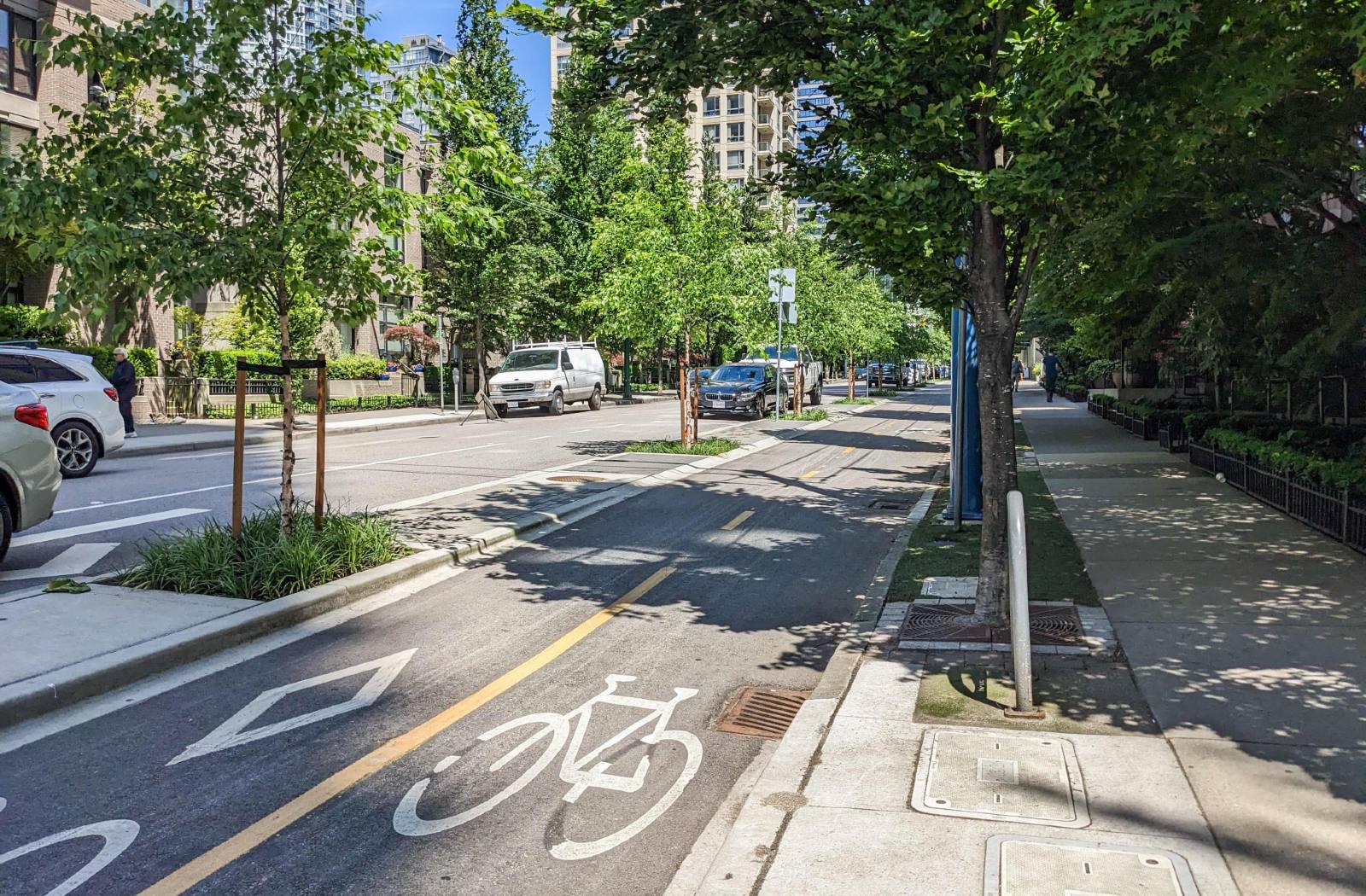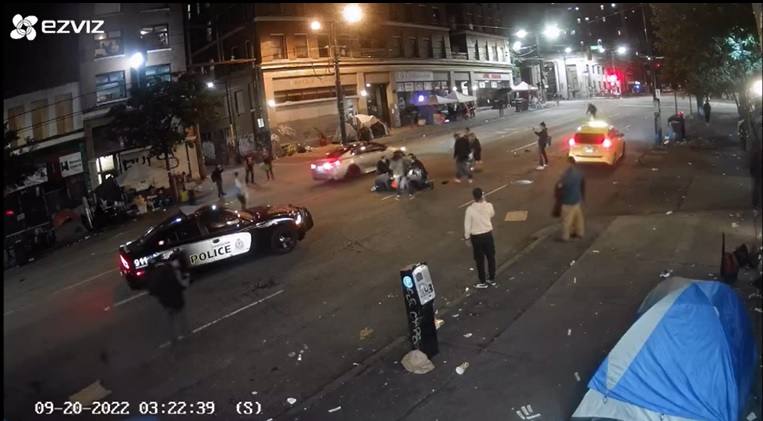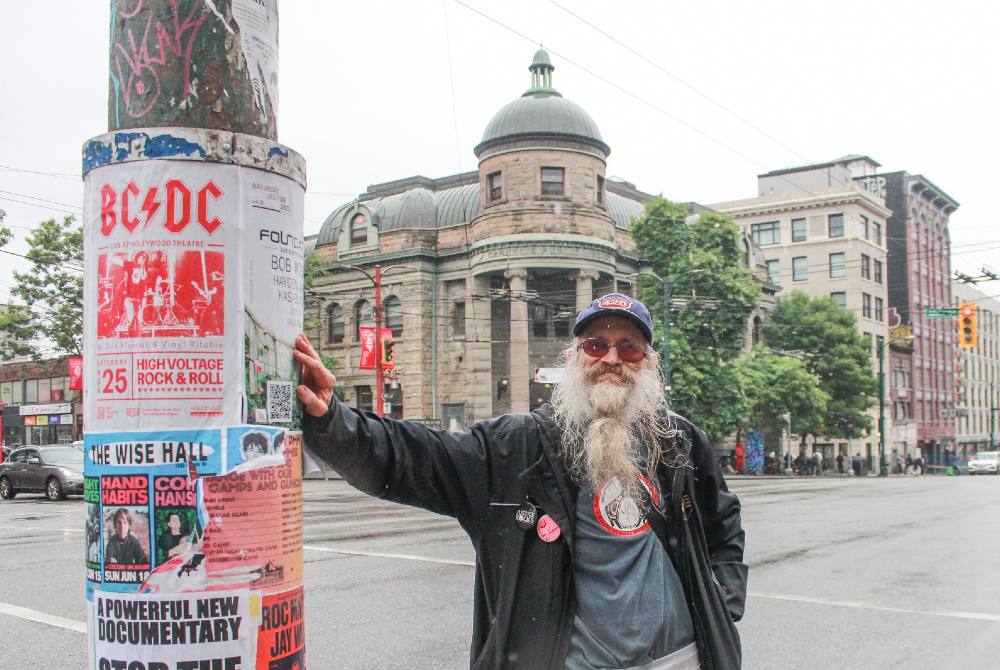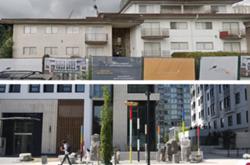“My mom told me to look both ways when I cross the street and that’s what I do.”
Taking her advice to heart, Dave Hamm has never been hit by a car, even though he lives near the deadliest intersection for pedestrians in the Lower Mainland: Main and Hastings.
According to 2022 ICBC data, there were nine crashes between vehicles and pedestrians at the intersection, part of 28 incidents on a seven-block stretch of Hastings between Abbott Street and Princess Avenue.
For the low-income Downtown Eastside, the bustling streetscape functions as a “living room,” he says. However, it’s a living room with six lanes of car and truck traffic running through it. Hastings Street is a gateway in and out of Vancouver’s downtown peninsula.
“We can make it safer for our pedestrian population,” said Hamm, who notes that a number have mental health and substance use issues. There are people who sleep on the sidewalks as well.
Hamm, 63 and a resident of the neighbourhood for 14 years, is a board member of the Vancouver Area Network of Drug Users, whose office is on busy East Hastings near Dunlevy. In 2009, VANDU published a pedestrian safety report, which spurred the city to make a number of changes including a “slow zone” on a stretch of Hastings that reduced the speed limit to 30 km/h, down from a previous 50 km/h.
Vince Tao, one of the group’s organizers, called that a “big community win,” though close calls with traffic still happen every day.
“The Downtown Eastside is a place historically where people depended on public space,” said Tao. “They are marginalized, shut out of say ‘regular housing’ where the rest of society can spend time and have some space to breathe. Here, people are living in SROs, essentially crummy cages. As the summer heats up, they are sweltering tinder boxes. So people’s dependence on public space is important to flourishing. They walk and work on the streets, they share life on the sidewalk. And that exposes them to dangers like speeding cars.”
While Vancouver might make it onto lists of top walkable and bikeable cities, the Lower Mainland is no different from other urban centres in North America that developed alongside the automobile: cars rule the streets.
Fatal crashes
Each year, an average of 2,000 crashes between vehicles and pedestrians occur in the Lower Mainland, according to ICBC data. About 1,800 result in injuries. Of those, about 31 result in deaths.
The number of crashes between vehicles and cyclists is markedly smaller. There are about 1,300 incidents each year, with 1,000 injuries and three deaths among them.
The top cause of crashes in the province are driver distraction, driver failure to yield right of way and weather, with a higher percentage of crashes happening in the darker months between October and January, says ICBC.
Are car crashes inevitable?
Should jurisdictions be treating crashes as “accidents” and an inevitable part of urban life?
In 1992, the Vision Zero project was founded in the Netherlands to refute such attitudes. Their name comes from the principle that there should be zero injuries or deaths involving road traffic. It encourages governments to adopt a “safe systems” approach. This layered approach — which involves infrastructure, driving laws, traffic rules and more — anticipates human error and considers human vulnerability, so that even if a crash were to occur, the victims wouldn’t be seriously injured.
Since then, a number of European countries have adopted the approach, with Sweden halving traffic deaths within two decades. In 2013, B.C. followed suit. Some Lower Mainland cities such as Vancouver and Surrey have since adopted the strategy, while others such as Richmond and New Westminster are considering it.
While Vancouver has created new crossings and street calming initiatives, efforts to change streets and roads often run into political challenges, not to mention opposition from drivers not used to a shift in the status quo.
“It’s hard to be opposed to safety,” the executive director of the U.S. National Association of City Transportation Officials told Bloomberg. But while politicians are happy to commit to Vision Zero, there are roadblocks when it comes to implementation.
In two recent decisions, Vancouver’s park board voted to dismantle separated bike lanes in Stanley Park installed during the pandemic, welcoming back vehicle traffic, and city council rejected separated bike lanes from a plan to turn Broadway into a “Great Street” in line with recommendations from staff.
Last March, city-installed “banana barriers,” yellow concrete strips intended to slow vehicles at key intersections, were criticized by drivers after some got their cars stuck on them.
The biggest barrier to slowing down car culture, according to geographer Nadine Schuurman of Simon Fraser University, is political will.
She once attended a meeting on improving the bikeability of the Sea to Sky Highway. She remembers someone from the provincial transportation ministry saying to bikers: “These roads aren’t built for you people. This is built for moving potatoes and truck parts.”
It was a revealing quote about the perception of what streets and roads are ultimately for. “Commerce is prioritized over walkability and bikeability,” she said.
Schuurman researches the relationship between pedestrian injury and the built environment. Her studies of traffic intersections examine everything from street furniture to demographics.
While car culture is a tough thing to change, the solutions that can save lives are in plain sight, she says.
“We do know that urban infrastructure effects behaviour profoundly. We can design away a lot of the risk.”
Tweaking traffic
Each intersection, says Schuurman, is situated in a unique context and requires individual attention to make improvements. Risk is complex to measure, with factors such as traffic volume, road width and land use all playing a role.
Far from the Downtown Eastside and Vancouver’s urban core, an intersection in a southern part of the city has climbed the ranks in recent years to become the second-most dangerous for pedestrians in the Lower Mainland: Cambie Street and 49th Avenue. Last year, it was the site of eight crashes between vehicles and pedestrians.
At first glance, the intersection might look quite suburban: no shops, no towers and humble houses at two of its corners. But Joy Kwan, a nearby resident of six years, says to look closer: “It pulls more than its own weight.”
Kwan, who uses the intersection twice a day, points to its role as a waystation.
There is dynamic traffic here. The south side has nine lanes: a mix of lanes for vehicle traffic, bike lanes and turning lanes. There is a Canada Line Station at the northeast corner, where many passengers who emerge from underground make a dash to catch their bus. The sidewalks are often crowded with transit users in the midst of their commutes or students rushing to class at nearby Langara College. This is also the intersection where the 49 bus stops. It’s the region’s third-busiest bus route, stretching from UBC to Metrotown in Burnaby.
It’s a multi-modal intersection, a representation of what other parts of the region could look like in the future if we make the shift from car dominance.
Kwan, who knows the intersection intimately as a regular pedestrian, driver and transit rider, praises the lights that direct the traffic as being “very well done.”
“But everyone is rushing,” said Kwan, noting that pedestrians often jaywalk to catch the bus. “You’ve got so many things coming together.”
While Schuurman has not studied this particular intersection, she has some general advice for intersection design to make them safer for users who share the road.
Protected intersections can reduce injuries. These include setbacks for stopped vehicles, to offer more distance between them and pedestrians and cyclists, and islands to prevent vehicles from turning sharply and where pedestrians and cyclists can also wait to cross with better visibility.
Separated bike lanes not only help with safety, but encourage more people to cycle. Even better if the lane is separated from traffic with a physical barrier, such as a strip of concrete. “That is the biggest impediment for people who are not bikers on Strava to actually participate in bike culture,” she said.

Long blocks can encourage jaywalking if there aren’t crossings to break them up. “Worldwide, one of the biggest risk factors for pedestrians is crossing in the middle of the block,” said Schuurman.
Signs are important, but not too many. “When there are so many signs that the driver goes into signage shutdown, they don’t read them,” said Schuurman.
Fighting for space
On Hastings in the Downtown Eastside, six lanes of vehicle traffic come to a stop at Main Street, where there are people crossing the street with canes, crutches and walkers, many of them seniors.
“Everyone here is a pedestrian; we can’t afford cars here,” said Tao at VANDU. When film crews, development sites and police cordons redirect traffic, it can be hard for residents to get around because of how busy the sidewalks are. People are tempted onto the road to bypass the obstruction, just like he did the other day.
There’s another important factor to consider when examining pedestrian injury: socioeconomic status.
“We know that for every health measurement, from cancer to pedestrian injury, the outcomes — not the risk of it happening — are better the higher your socioeconomic status,” said Schuurman. “Money and education really dictate how you recover from anything.”
The presence of vehicle traffic in a neighbourhood, she adds, is often an indicator of privilege. High-income housing is kept away from traffic whereas low-income housing is often near at least four lanes.
That exposure is something Downtown Eastside residents live with every day. Last March, a truck hit and killed a 57-year-old man crossing Hastings. Also that month, a single vehicle struck three pedestrians who were hospitalized. Last September, a man was hit by a police car, and still struggled with pain, vision problems and difficulty walking six months after the incident. “How are we supposed to trust the VPD to enforce the speed law?” said Tao.

“This structurally excludes low-income people. If we’re talking about people in the Downtown Eastside, who are disproportionately hit by cars, they’re not going to get shit from it.”
While ICBC has its data, it’s likely that many crashes in the Downtown Eastside are unreported. A new data project to collect this information is in the works at VANDU, as it’s been 14 years since their last report. There are also big changes coming soon to this part of the city. The coming relocation of St. Paul’s Hospital to the community and the development of the remaining empty sites along False Creek will shift traffic patterns.
In the meantime, Tao has a few fixes in mind. Longer lights for pedestrian crossings. Guard rails to separate people from cars.
They might seem like “crude” additions, he says, but they save lives.
“There’s a tension here because those streets are our homes. It really is a battle over public space and who has the right to it.” ![]()
Read more: Rights + Justice, Transportation, Urban Planning

















Tyee Commenting Guidelines
Comments that violate guidelines risk being deleted, and violations may result in a temporary or permanent user ban. Maintain the spirit of good conversation to stay in the discussion and be patient with moderators. Comments are reviewed regularly but not in real time.
Do:
Do not: